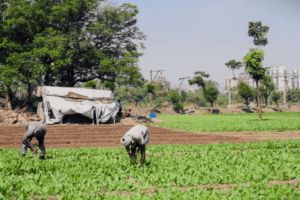In this blog Anjana Nair discusses the dynamics and scope of agri journalism in India.
CONTEXT
Agriculture journalism is embedded in the psyche of every agriculture science graduate. The very mission of the educational system at the graduate level in agriculture is to nurture the journalistic instincts in them, and they ultimately become an information disseminator for the sector. Agriculture Extension, a basic subject taught in all agricultural colleges across the country, by definition means ‘to expand or extend’ the work of universities beyond the campus and into the neighbouring community. It is essentially meant to transmit the practices and knowledge in agriculture to the end user – the farmers – in a language that is suitable and clear to them. The remaining subjects taught are meant to groom students and to let them understand the basics so that their communication becomes more effective. So, it wouldn’t be an overstatement to say that all agriculture graduates are nurtured to be agri journalists. They are all journalists in waiting!
CHANGING DYNAMICS OF AGRI JOURNALISM
Journalism is the systematic and reliable dissemination of public information, public opinion and public entertainment by modern mass communication media. Agricultural journalism is a specialized branch of journalism which exclusively deals with disseminating information gathered from different sources in a presentable format through various media, such as newspapers, periodicals, radio, TV, internet, advertising, and so on. The process is elaborate and entails several phases: receiving news, writing it up in the appropriate format, editing the content, and then reporting it through the relevant media. The content, most often will be supported by photographs, and dissemination happens through newspapers, magazines, radio, television and the internet. And as agriculture bloomed and matured, the branch of agriculture journalism has also diversified.
From being a more print-oriented segment, it started to lean more towards the visual side. According to me, the disturbances and stress brought on during the COVID period spurred a revolution and the Audio Visual (AV) media basically won over the print media. The change is understandable as the AV segment does not entail the painstaking effort of reading. The news or content complemented with video and audio essentially made it ‘instant’ news. With the added flexibility of it being available for viewing at any time and every time through a handheld device, news travelled in the pocket of the news seeker. While print became the comfort of those who wanted good writing and details, the audio-visual media became the choice of the masses. One thing must be emphasised – it created a revolution in journalistic circles. It led to an explosion of news and content. Knowledge has become freely and easily available.

Today millions can access the news simultaneously. News has ceased to be a one-dimensional activity. One thing that stands out in the era is the continuous engagement of readers with the news. The modern digital infrastructure has helped them to converse and interact with the news. This engagement has, therefore, resulted in enhancing the intended purpose of news in multiple ways. So a farmer who sees a new technology being used by another in a faraway region can reach out for information, technology and assistance. The speed between action and reaction has considerably shortened.
Readers can now also become source of news. They can share news and then the news may reach many new ears. News has turned now into a source of knowledge, entertainment, and thus acquired the status of showbiz. The activity that was once meant to convey a message has now the added responsibility of making the news engaging. So the new age journalist ends up twisting, moulding and fashioning the news so as to align it with the sensibilities of the reader/viewer. Instances of news being created have become common and (maybe!) a necessity. Finding news and putting out a bait for news have become an accepted fact. The proliferation of news and news sources has created this whirlpool of information and misinformation. Now the responsibility rests on the readers’ wisdom – to discern and take a call on what to believe and what not to.
AGRICULTURE JOURNALISM’S EXTENDED SCOPE
Agriculture journalism is an important field. As India is a nation with more than sixty percent of people dependent on agriculture, every news item that is related to agriculture automatically becomes the news of the nation. MSPs, policies, exports, embargoes – all are newsworthy – and so any traditional news agency will be delighted to have an agriculture journalist on board, although it is highly unlikely that they would root for a candidate with an agriculture background. The number of candidates with a journalistic background out number agri graduates who would prefer a job in the media rather than a job in the government sector.
Content creators of the new world too fall into the category of journalist, and as freelancers they (far too eloquently) disseminate information and news. Trade magazines related to agriculture have emerged and they provide an open access platform for authors to spread awareness on developments in the agriculture sector. As the content and readers are agri sector specific, the job should technically require someone who understands them easily and can create content convincingly. Sometimes the articles need to be converted into a popular format. So, in that case, the agri journalist becomes an interface between the industry and the readers.
Another very promising area is the communication departments of many corporate houses who are increasingly invested in propagating the news from the companies to spread awareness on their technologies and activities. They need someone to communicate with the outside world on their achievements, or to create content for their brochures, websites, and press releases.
The world stands at the threshold of new communication systems and the communicators therefore need to evolve and integrate with it. As news has become interactive and requires instant dissemination, the agriculture journalist needs to stay abreast or ahead of what is happening in the world. I believe they have to be evolved breeds of agriculturists, staying awake and always one step ahead.
 Anjana Nair is Group Editor, Agricultural Today (https://www.agriculturetoday.in/).
Anjana Nair is Group Editor, Agricultural Today (https://www.agriculturetoday.in/).
She is an experienced Agriculture professional who considers dissemination of knowledge and information from authentic sources a primary responsibility. She remains associated with India’s prime agriculture magazine and has been instrumental in bringing out contents of quality through interventions in the form of article/interviews from eminent personalities in agriculture sector (Email: anjana.rajeshwari@gmail.com)





Add Comment